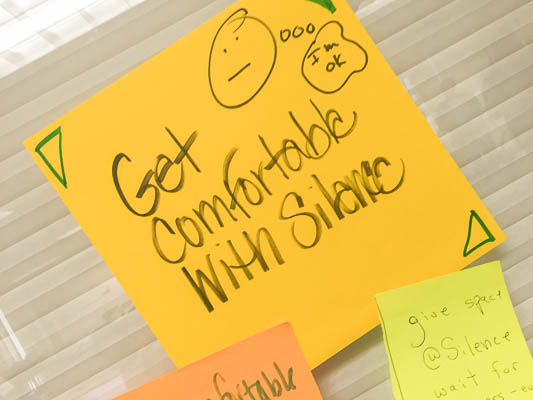
The Power of Good Questions
Have you ever asked a question and everyone just looked at you like you were speaking a foreign language? Or even worse, they don’t look at you at all and act like no sounds left your lips?
Yeah, I know those faces too. The awkward silence when you question your worth, your sanity, and why you got into this training thing anyway.
Consider for a moment the questions you ask. Chances are they sound something like these:
“Did that have value you for you?”
“Who has questions?”
“What does this all mean?”
You can probably add a few more to my list.
Take a look at them for a moment. Do you notice anything about them? Do they have anything in common?
There are two blaring problems with these questions and, most likely, with the questions that illicit that void look.
The questions are either too narrow or too big. Like Goldilocks, your learners are looking for that JUST RIGHT spot.
So how do you find the sweet spot?
Let’s start with the questions that are too narrow.
The first rule of questioning:
Give them something to answer.
Closed ended questions like who has questions and did that have value for you don’t require much response.
Yes. No.
Done.
No one is engaged with narrow, closed ended questions. No matter how many you ask and no matter how amazing you are, they aren’t going to provide the spark to discussion you are looking for.
Before you ask what questions to replace those with, let’s explore the second rule of questioning.
The second rule of questioning:
Don’t go deep until they are ready.
We need a little mental warm up before we can ask deep questions about meaning and value. So what do we do?
We start simpler, but remember, not narrow.
Begin with the obvious. The easy. The facts that are hard to deny.
What did you see, hear, touch, taste?
They would sound something like:
- What happened during that exercise?
What did you notice? - What did you hear?
- What did you see?
Get it? Easy, right? Obvious and answerable.
Once we’ve covered the senses, then dig into the feelings. Not just good feelings though, we want the range. We can elicit that range by asking two distinct questions.
- What did you like about that activity?
- What did you dislike?
You could get it all done with one question, “how did you feel about that activity.” Up to you, obviously.
Now you’ve primed the mental pump, learners are better prepared to answer deeper questions.
If our goal is action, let’s consider a two step process.
First ask about what the value or the learning was. Once you identify that, then they are ready to explore the actions they can take.
Questions can lead people to discover things they didn’t realize through the activity they experienced. As my friend Thiagi says, the learning is in the debrief. Debrief well.
Here’s a quick look at what you might ask after the next big activity you conduct or as a final review at the end of a training day.
- What do you recall from today?
- What did you like?
- What did you dislike?
- What did you learn from today?
- What will you do differently when you get to work tomorrow?
Remember as you ask these questions, you are taking on a facilitator role. You are asking the questions, not answering them. It’s going to be tempting to throw your two cents in, but don’t.
Tips For Asking Great Questions

[…] focusing on questions rather than jumping to solutions. I’m a fan of questions and have loved the focused conversation debrief method for a long time. Gregersen’s approach was new to […]
[…] I’ve never reached zero. If you do get all the way to zero you might consider your question. Was it answerable? Are learners safe? Was it too difficult or too easy? Read more about the power of good questions. […]